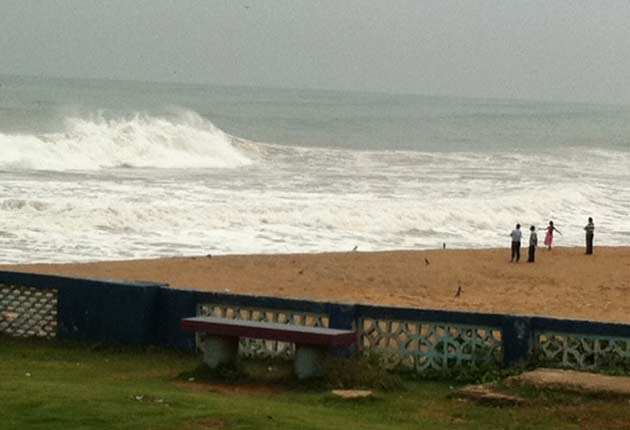
What's in a name of a cyclone, one may wonder. But overnight the name becomes familiar and attains an iconic status of sorts and is on everybody's lips! Be it Nargis, Rashmi, Khai-Muk, Nisha, Bijli, Aila or Laila!

As category 4 upgraded to 5 super cyclone headed for a landfall on Saturday evening , it is Thailand that got the turn to name this cyclone in the Indian Ocean as 'Phailin', that is now on top of everyone's mind . Phailin is sapphire in Thai as the country took it's turn procedurally laid down by the World Meteorological Organisation (WMO) and the United Nations Economic and Social Commission for Asia and the Pacific (ESCAP) at it's meeting of the Panel on Tropical Cyclones in 2000.While names of people are avoided the database of names are from those selected that are familiar to the people in each region,"
The names of the Cyclones is authorised to the Regional Specialised Meteorological Centre (RSMC), housed in the Indian Meteorological Department 's Mausam Bhavan in New Delhi, that picks up the names ready on the list. The RSMC has been set up in Delhi by the WMO for forecasting tropical cyclones in the Arabian Sea and Bay of Bengal.
As the cyclones and hurricanes leave a trail of destruction a database is prepared later around the names for an assessment and action plan of the devastation, much later.
While the Nation awaits with a bated breath over Phailin, the next cyclone in the Indian Ocean - whenever it comes - has already been named - Helen by Bangladesh !


 The cyclone that is headed towards the Andhra Pradesh and Odisha coast along the Bay of Bengal is named 'Phalin'. Phailin is the Thai word for sapphire and according to the followed procedure of naming tropical cyclones over north Indian Ocean it was turn of a name suggested by Thailand in the list of assigned names. The next cyclone in the region will be called Helen, a name from the list of cyclone names given by Bangladesh. The practice of naming tropical cyclones began years ago in order to help in the quick identification of storms in warning messages because names are presumed to be far easier to remember than the numbers and technical terms. Many agree that appending names to storms makes it easier for the media to report on tropical cyclones, heightens interest in warnings and increases community preparedness
The cyclone that is headed towards the Andhra Pradesh and Odisha coast along the Bay of Bengal is named 'Phalin'. Phailin is the Thai word for sapphire and according to the followed procedure of naming tropical cyclones over north Indian Ocean it was turn of a name suggested by Thailand in the list of assigned names. The next cyclone in the region will be called Helen, a name from the list of cyclone names given by Bangladesh. The practice of naming tropical cyclones began years ago in order to help in the quick identification of storms in warning messages because names are presumed to be far easier to remember than the numbers and technical terms. Many agree that appending names to storms makes it easier for the media to report on tropical cyclones, heightens interest in warnings and increases community preparedness
.


Here's all that you need to know about the tropical cyclone Phailin:
# It is classified as a Severe Cyclonic Storm. The India Meteorological Department's (IMD), latest bulletin says it originated over east central Bay of Bengal and has now intensified as it moved Northwestwards 800km southeast of Paradip, and 870 km east-southeast of Visakhapatnam.
# Originated from an area of low pressure over the Andaman Sea, Cyclone Phailin would move close to Gopalpur (Odisha) by evening of 12th October with a maximum sustained wind speed of 175-185 kmph, the IMD said.
# Under the influence of this system, coastal Odisha should expect heavy, very heavy and isolated areas of extremely heavy rainfall starting saturday morning.
# The storm will continue and extend to interior Odisha and coastal areas of Gangetic West Bengal from Sunday morning.
# Heavy to very heavy rainfall would also occur at a few places over the north coast of Andhra Pradesh commencing from Saturday, October 12. Very heavy rainfall would occur over coastal areas of West Bengal from Sunday, October 13.
# Cyclone Phailin would intensify with maximum sustained wind speed reaching 175-185 kmph along and off coastal districts of north coastal Andhra Pradesh and south Odisha.
# State of Sea along and off Odisha and north Andhra Pradesh coast will be rough to very rough from Friday morning.
# Extensive damage is expected to kutcha houses and agricultural crops. The cyclone would also lead to partial disruption of power and communication lines.
# Minor disruption of rail and road traffic along with potential threat from flying debris is also expected.
# Flooding caused by storm surge with height of around 1.5-2.0 m would inundate low lying areas of Ganjam, Khurda, Puri and Jagatsinghpur districts of Odisha and Srikakulam district of Andhra Pradesh during landfall.







